Analysis to follow, perhaps. Lots of mistakes made.
Analysis to follow, perhaps. Lots of mistakes made.
Preparing the b4 pawn push, supported by the rook, to be followed up by b5, especially if there is a knight on c6, and a4, grabbing lots of queenside space and waiting for the opponent to commit to placing his pawns in the center before deciding what to do with the central pawns and kingside pieces. Prevents black's king's bishop from developing naturally to c5 or b4, and has the possibility of giving white two nice diagonals to place his bishops on: a3-f8 or a1-h8 and a2-g8. Probably has a high propensity to getting creamed on the kingside, but good for a laugh, especially in 1 minute games, like the following [the same opening idea but reversed, as black].
The same idea as white, accidentally in a 5 minute game, intended for a 1 minute game.
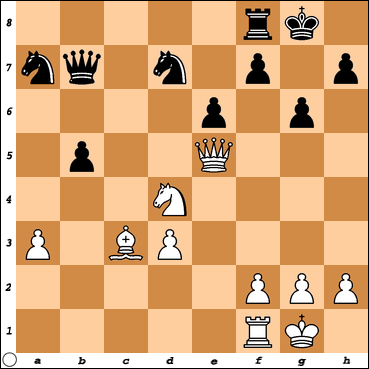
Exciting position from the game Evgeny Sveshnikov vs. Ruslan Scherbakov, 1991. White to move and mate in three.
1. Qg7+!! White sacks his queen to trap black's king in a mating net ... Kxg7 the only move. 2. Nf5++ The double check forces black's king to move and prevents him from escaping via h6 ... Kg8 the only move. 3. Nh6# or 3. Ne7#
From a different game, a tactical puzzle. Black to move and win material. White has just played Bh6.
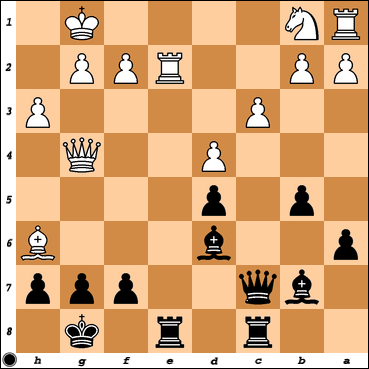
1 ...f5! Black covers the g7 square with his Queen and simultaneously attacks White's queen, which must protect the rook on e2 as well as pin the g-pawn so that it cannot take the bishop on h6. If 2. Rxe8+ Rxe8 as was played in the game, 3. Qd1 must be played to prevent ...Re8#, losing the bishop. The best line for white is 2. Qh5 Rxe2 3. Qxe2 gxh6 4. Qe6+ Kg7 5. Qxf5 Bh2+ 6. Kh1 (6. Kf1 Qc4+ leads to mate)
Here is a fun game I just played on the Free Internet Chess Server. If you copy-paste this as a PGN into your viewer you can read my comments as well as look at some variations.
[Event "rated blitz match"]
[Site "Free Internet Chess Server"]
[Date "2009.05.08"]
[Round "?"]
[White "waparker"]
[Black "pencsev"]
[Result "1-0"]
[WhiteElo "1171"]
[BlackElo "1048P"]
[ECO "C41"]
[TimeControl "300"]
1. e4 e5 2. Nf3 d6 3. d4 exd4 4. Qxd4 Bg4 5. Rg1 $5 {A cute little move to have some fun that I just came up with. If black takes the knight and opens the g-file, he will basically be forfeiting the right to castle on the kingside, and the development of his dark-square bishop might be difficult due to the pressure on g7. But it's definitely not a very sound idea.} Qf6 6. Qe3 (6. Qb4 Bxf3 7. gxf3 b6 8. Nc3 Qxf3 9. Nd5 Kd8 $16 {If black goes for pawn-grabbing, white will have a lead in development and threats on c7 to force the king to forfeit the right to castle.} ) Nc6 7. Nc3 a6 8. Bd2 (8. Nd5 Qd8 9. Qb3 Rb8 10. h3 Bd7 11. Bd3 ) O-O-O 9. O-O-O Nd4 10. Be2 (10. Nd5 Qg6 11. Qxd4 $18 {A simple tactic to win a piece. The queen can't stay on the diagonal to protect the knight.} ) Nxf3 11. gxf3 Be6 12. Kb1 (12. Qa7 b6 13. Qa8+ Kd7 14. Qxa6 g6 15. e5 Qf5 16. Bb5+ c6 17. Qb7+ $18 ) Kb8 13. Bd3 d5 {Black offers to open up lines when he is the player with poor development.} 14. exd5 Bxd5 15. Nxd5 Rxd5 16. Be4 Rb5 17. Bc3 Qb6 (17. ... Qe7 {A better alternative to the move played which immediately loses;} 18. Rd2 Rb6 19. Ba5 Rd6 20. Qb3 b6 21. Bb4 Qe5 22. Rgd1 Rxd2 23. Rxd2 Qg5 24. Qd3 $18 ) 18. Rd8+ Ka7 19. Qxb6+ (19. Rxf8 Qxe3 20. fxe3 c5 21. Rxg7 ) cxb6 20. Rgd1 (20. Rxf8 f5 21. Bd3 Rd5 22. Bxg7 ) Bc5 (20. ... Be7 21. R8d7 Kb8 22. Bxb7 Bf6 23. Bxa6 Rg5 24. f4 Rg6 {Rybka gives Rg1, sacking the rook to stop white's rook coordination. This more human-like move leads to checkmate.} 25. Be5+ Bxe5 26. Rb7+ Kc8 27. Rxf7+ Kb8 28. Rd8# ) 21. R1d7 a5 22. Rxb7+ Ka6 23. Ra8# {pencsev checkmated} 1-0
Featuring three games: two from me, and one from Paul Morphy, the famous Opera Game.
I achieved my highest blitz rating on FICS last night of 1234. I think making live videos will improve my ability to make plans quickly and avoid indecision. I have actually been winning some five minute games instead of losing on time!
Here is a game from the book Logical Chess: Move by Move by Irving Chernev. Try to go through the moves in your head without looking at a board. It's not a long game so it should be possible.
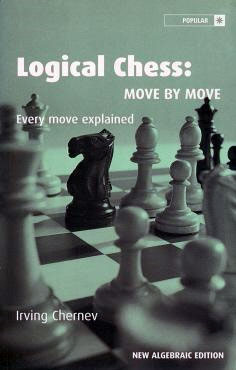
A highly recommended book.
von Schieve - Teichmann Berlin 1907 - Guioco Piano
1. e4 e5 2. Nf3 Nc6 3. Bc4
This game comes from the "kingside attack" chapter of this book. A good development of the bishop, it is aggressively pointed at f7. It also contests the d5 square.
3 ... Bc5 4. c3
White aims to establish the central pawn duo of e4 and d4. This c-pawn thrust also makes Qb3 an option to attack f7. It does, however, deprive the queenside knight of his best square. The threat is 5. d4 attacking the bishop and forcing 5 ... exd4 6. cxd4.
4 ... Qe7
Black counters the threat by counterattacking on the e-pawn. If 5. d4 exd4 6. cxd4 then 6 ... Qxe4+ wins the pawn.
5. O-O d6 6. d4
White delayed the d4 thrust to castle his king. The move indirectly protects the e-pawn, because 6 ... exd4 7. cxd4 Qxe4 8. Re1! and the queen is pinned and will be lost.
6 ... Bb6
Black's move d6 allows him to retreat his bishop after 6. d4 and not lose his central pawn.
7. a4 a6 8. a5
White is losing time on a fruitless attempt to trap the bishop or fool black. If 8 ... Bxa5 then 9. d5! Nd8 10. Rxa5 wins a bishop. But black does not fall for it.
8 ... Ba7 9. h3
A weak move that I have been seeing alot in blitz games on FICS. White wants to prevent Bg4 pinning the knight, but it is unnecessary. Chernev writes, "It is better to submit to the pin -- a temporary inconvenience -- than to prevent it by a move that looses the position of the pawns defending the king." Now Bxh3 is a constant option for black to trigger a kingside mating attack.
9 ... Nf6 10. dxe5
Black is poorly developed, so opening up lines in the center will favor black. White has just increased the scope of black's a7 bishop, which now pins the f2-pawn to the white king.
10 ... Nxe5 11. Nxe5 Qxe5
Black is right to replace his e-pawn with pieces. Now white's knight on f3 -- the best defender of the white kingside -- has disappeared, replaced by a powerfully placed queen on e5.
12. Nd2
Although the white e-pawn is attacked twice and defended once, taking it would cost the game: 12 ... Nxe4 13. Nxe4 Qxe4 14. Rc1 pinning the queen.
12 ... Bxh3!
Black has no interest in the e-pawn; he is more interested in the white king.
13. gxh3 Qg3+!
A powerful move; black is utilizing the pin on the f-pawn thanks to the bishop on a7.
14. Kh1 Qxh3+ 15. Kg1 Ng4
Threatening mate on h7. One try that fails immediately is 16. Re1 to give room for the king, which is met by 16 ... Bxf2#.
16. Nf3 Qg3+
Removes one of the defenders, the king, from protection of the f-pawn as well as attacking it a third time with the queen.
17. Kh1 Bxf2! 0 - 1
White resigns. The bishop is taking away the g1 square for the king to escape to, so that black is threatening 18 ... Qh3+ 19. Nh2 Qxh2#. Unfortunately for white, the bishop cannot be taken, because of 18. Rxf2 Nxf2#.
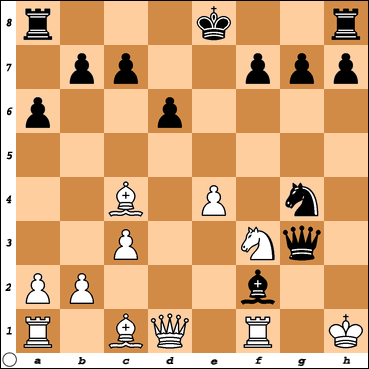
I'm having fun making the videos- it gives a new sense of life to the game of chess for me because it allows a different angle from which one can look at the game.
1. A serious production, a presentation of the game Leko vs. Gelfand from yesterday's Grand Prix Tournament in Nalchik. It was an exciting middlegame! Link
2. A non-serious production. A humorous, poorly played, clownish game on my part which started well and went terribly wrong. But spotting one tactic is enough to turn a loss into a win. Click at your own risk
Suggested link: The Nalchik tournament website
I've been on a tear. I even started a Youtube channel!
A fun live blitz game with a very winning rook and pawn ending,
here.
A couple of fun live blitz games, on my new youtube channel!
Go!
I have another video ready, which is a 20 minute analysis of a classic game from 1905, Janowski vs. Alapin. I haven't uploaded it yet because I'm not sure about a copyright issue, because it's a game from a book I am reading. So I will hopefully post that soon! It utilizes ChessBase and the colored squares and arrows! Fun!

Today I tried out the King's gambit in one game, and I tried two games in the Vienna game, 1. e4 e5 2. Nc3. It looks quiet and passive, but can lead to very aggressive and tactical play for white if he plays an early f4 ala the King's Gambit. In fact, Wikipedia cites, "Weaver W. Adams, whom Grandmaster Larry Evans described as having an 'all or nothing' mentality, famously claimed that the Vienna Game led to a forced win for White."
I wouldn't go that far, but it can lead to some quick development and powerful attacking chances. I will relay some basic guidelines to the opening from Wikipedia's article. After 1. e4 e5 2. Nc3 black has two options. If 2 ... Nf6 white can play 3. f4, the Vienna Gambit, which can lead to open lines against the black king if black does not defend properly. In the few games of blitz I have played I have seen most often 3 ... exf4, but 3 ... d5, a counterstrike in the center, is indicated for black to keep it equal. After 3 ... d5, "4. fxe5 Nxe4, either 5.Nf3, 5.Qf3 or 5.d3 usually follows." After 3 ... exf4 I have been playing 4. Nf3 like the King's Gambit but 4. e5 Qe7 5. Qe2 is another good line, as black's knight must retreat. 3 ... d5 does not seem like a move likely to be found in blitz games, unless the black player knows a little bit about the opening.
 |
| I felt like spicing up my blog posting with a picture of Vienna. |
Other options after 2 ... Nf6 include 3. Nc4 which can transpose into countless different openings, such as the Four Knights Game, Bishop's Opening, or King's Gambit Declined, and though there are some "wild" lines discussed in the Wikipedia article, this move is not really my main focus at this time. Another popular idea is 3. g3 which prepares the kingside fianchetto and a quieter more positional game, which may be a useful idea if playing a slow game against someone who knows his stuff. The move has been played by Vasily Smyslov, "most notably in a win over Lev Polugaevsky in the 1961 USSR Championship. That game continued 3...d5 4.exd5 Nxd5 5.Bg2 Be6 6.Nf3 Nc6 7.O-O Be7 8.Re1 Bf6 9.Ne4 O-O 10.d3 Be7 11.a3 Nb6 12.b4, resulting in a position which the Encyclopaedia of Chess Openings assesses as slightly better for White. The main line today, however, is considered to be 5...Nxc3 6.bxc3 Bd6 7.Nf3 O-O 8.O-O."
After 2 ... Nc6 there are still the 3. f4 or 3. g3 ideas, and in either case, "3...d5? would be a weak response losing a pawn, unlike after 2...Nf6." A good sharp line for blitz games might be the Hamppe-Muzio gambit, 1.e4 e5 2.Nc3 Nc6 3.f4 exf4 4.Nf3 g5 5.Bc4 g4 6.0-0 gxf3 7.Qxf3, where white is down a piece but has a significant advantage in central space and development, and has the f-file and the weakened a1-h8 diagonal to generate a powerful attack with.
Now I will recount a game just played on the FICS server in the Vienna/ King's Gambit.
[Event "rated blitz match"]
[Site "Free Internet Chess Server"]
[Date "2009.04.17"]
[Round "?"]
[White "waparker"]
[Black "ayi"]
[Result "1-0"]
[WhiteElo "1145"]
[BlackElo "1254"]
[ECO "C25"]
[TimeControl "600"]
1. e4 e5 2. Nc3 Nc6 3. Bc4
Unsure of whether I want to go in for the 3. f4 lines, as I have heard that 3. f4 is not as good against 2. Nc3.
3 ... Nf6 4. f4 exf4 5. Nf3 h6 6. d4 g5 7. h4 g4
Gives white the advantage. Better for black would have been 7. ...
Bb4 8. d5 g4 9. dxc6 gxf3 10. gxf3 bxc6 11. Bxf4 d5 12. exd5 cxd5 13. Be2 and black has better central control but white has a small advantage. Note in this hypothetical position black cannot attack the pinned knight because if 13 ... d4 14. Be5 dxc3 15. Qxd8+ Kxd8 16. Bxf6+ Ke8, and here 17. Bxh8 would be a weak move leading to material equality as opposed to 17. O-O-O which threatens checkmate and the hanging rook on h8 simulataneously, which will win material.
8. Ne5 Nxe5 9. dxe5 Nxe4
Not good. My opponent spent much time on this move so I could predict that he was thinking of sacking his knight instead of humbly retreating it. It only took a few moments to decide that 10. Nxe4 would not be very strong because of 10 ... d5 forking knight and bishop, and 10. Qxg5 would lose a piece to 10 ... d5 discovering an attack on the queen. Rybka suggets for black 9. ... d5 10. exd5 Nh5 as the immediate 9. ... Nh5 loses a pawn to 10. Qxg4 d5
11. Bb5+ c6 12. Qxh5 cxb5 13. Nxd5 White is a pawn up with an aggressively placed Queen and knight.
10. Bxf7+
Not the strongest continuation, but it displaces the king and regains material equality. (10. Qd5 Qe7 11. Nxe4 Rb8 12.
Bxf4 b5 13. Nf6+ Kd8 )
10 ... Kxf7 11. Qd5+ Kg7 12. Qxe4 f3 13. h5
Not the strongest continuation. I thought it was clever to threaten mate in one with a pawn push, because I didn't see anything concrete after 13. Qxg4+, but Rybka is better at looking 9 moves deep than I am: 13. Qxg4+ Kh7
14. Qe4+ Kg8 15. gxf3 Rh7 16. Nd5 Be7 17. Be3 c6 18. Rg1+ Rg7 19. Rxg7+ Kxg7
20. Nxe7 Qxe7 21. O-O-O {Black can do nothing to stop the threat along the
g-file} d5 22. Rg1+
13 ... Kf7??
Leads to a mate in two; black missed a continuation leading to equality by 13. ... Rg8 14. Qxg4+ Kh8 15. Qxf3 d5 16. Be3 d4
17. O-O-O
14. Qg6+ Ke7 15. Nd5# {ayi checkmated} 1-0
Note: I have found another great youtube chess commentator, SeanGGodley. He has a great series of Grandmaster miniatures which all feature great tactics in sharp positions and a number of subvariations, with good explanations of what moves are strong and what are not.
I am back from an extended hiatus from online chess. Here is a game in which I was quite happy with my position out of the opening. I think this is the primary benefit of blitz chess. It really is not enough time to calculate a winning combination to convert a positional advantage into a win. But it is a good venue to practice opening ideas and hone one's skills at evaluating the static and dynamic characteristics of positions and moves. Thus, I am trying to work on being happy if I am 24 moves into a blitz game and I have control over a central square that I can use as a home for a knight, or I have a strong pair of rooks blasting down an open file. I am sad if I am 24 moves into a blitz game and I am passively defending a backward pawn or have just hung my knight.
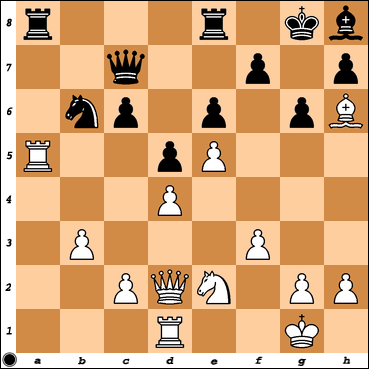
Position after 24. Rxa5
In this game at move 24 I have just won the a5 pawn, I have control over some dark squares in the center, my opponent's dark square bishop is hiding passively in the corner and "biting on granite" on my strong central pawn chain. My pawns are defending the c4 and e4 squares, limiting the activity of my opponent's pieces.

Position after 30. c4
After a few moves, everything has fizzled out. I must have missed something because my dream of establishing a knight on the powerful c5 square has not come to fruition. I must have missed something else, because my dream of establishing my rook on my opponent's 7th rank by Ra7 did not turn out to be possible by 29. Rxa8. Although I have a considerable static positional advantage, I am not able to take the initiative and win the game because of the passive placing of my queen and knight. That is, I do not have a dynamic positional advantage.

Position at which I was flagged on time
The most heartbreaking part of this game is where I am in a position with a very simple mate-in-two, but run out of time. But it's okay, because it's the first 7 minutes of a blitz game that really matter, right? At least, after losing in this manner, it helps me establish some peace of mind to think in this way.
The game. A pirc defense that had some ideas cross over from the King's Indian Defense and Philidor's defense.
Hello world. I have played my first chess game in a few days. I have been playing Scrabble but felt like a little chess action. It was a good game, but looking at it with Rybka's analysis just makes me a little depressed. I don't really feel like saying anything about this... I don't think I'm mentally ready to come back to playing chess as often yet.

[Event "rated blitz match"]
[Site "Free Internet Chess Server"]
[Date "2009.03.27"]
[Round "?"]
[White "MrGambitMan"]
[Black "waparker"]
[Result "0-1"]
[WhiteElo "1266"]
[BlackElo "1200"]
[ECO "B23"]
[TimeControl "600"]
1. e4 c5 2. Nc3 g6 3. Bc4 Bg7 4. Nf3 d6 5. d3 Nf6 6. Bg5 Nc6 7. Nb5? (7. O-O O-O 8. Qd2 ) a6 8. Na3 b5 9. Bb3 Bg4 10. O-O Nd4 11. Bxf6 Bxf6 12. Bd5 Rc8? (12. ... Rb8 13. c3 Nxf3+ 14. gxf3 Bh5 ) 13. Bb7 Rc7 14. Bxa6 Bxf3 15. Bxb5+? Kf8? (15. ... Nxb5 16. gxf3 Nxa3 17. bxa3 ) 16. gxf3 e6 17. c3 Nxb5 18. Nxb5 Rb7 19. a4 Be5 20. Qd2 Qh4! 21. f4? Qg4+ (21. ... Bxf4 22. f3 ) 22. Kh1 Qf3+ 23. Kg1 Bxf4 24. Qd1?? (24. Re1) Qh3 25. Qg4? (25. Re1 Bxh2+ 26. Kh1 Bg3+ 27. Kg1 Qh2+ 28. Kf1 Qxf2# ) Qxh2# {MrGambitMan checkmated} 0-1
I'm going to try something new this time. I'm going to look at some random positions from this book Combinations: The Heart of Chess by Irving Chernev which is a really, really old book - from 1960. I'm going to utilize my newly learned Javascript trick from last post, so under each position will be my proposed line and on the right will be the solution from the book. So let's get started and see where it takes us.
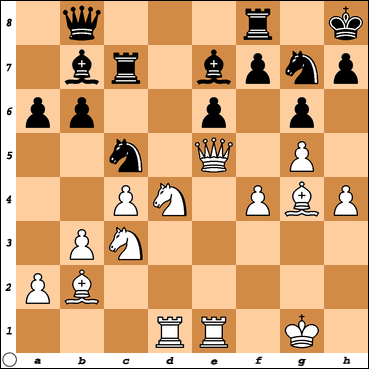
White to move. Gereben-Troianescu 1951
1q3r1k/1br1bpnp/pp2p1p1/2n1Q1P1/2PN1PBP/1PN5/PB6/3RR1K1 w - - 0 1
I have a feeling there is something more here. 1. Nxe6 {threatening checkmate} Nxe6 2. Nd5 {uncovering the bishop to threaten mate on g7 and attacks the rook} f6 {attacks the queen to save both the rook and mate 3. Qxc7 Qxc7 4. Nxc7 Nxc7 5. Rd7 Bd8 6. Bxf6 Bxf6 7. gxf6 Rxf6 {can't allow gxf7+ picking up the rook} 8. Rxc7 and white has a dominating position and is up the exchange.
Note: Rybka analysis reveals Nxe6 as a mistake that loses a 4 pawn advantage; suggests 2 ... Bxd5 as the newly placed knight on e6 is guarding the mate, so 2 ... f6 would not be played.
1. Nd5! {Attacks the rook and cannot be taken as it threatens 2. Qxg7+! Kxg7 3. Nf5+ Kg8 4. Nh6#} 1 ... Rfc8 2. Nxe6 {threatens mate on g7} Nxe6 {the one that's not pinned, of course} 3. Bxe6 {renews the threat} Bc5+ 4. Kh2 fxe6 {covers g7 with the rook on c7} 5. Nxc7 Rxc7 6. Rd7! {Gangs up on the pinned rook and blocks its control of g7. Looks like black is forced to give up his queen e.g. Rybka: 6 ... Bf8 7. Rxc7 Qxc7 8. Qxc7} 1-0
Ok. Maybe I should try an easier one. I will flip to the chapter called "Simple and Pleasing".

White to move. Tarrasch-Amateur 1919
1R6/2p5/Rnk1p3/1pppP3/1P6/2P5/2K5/7r w - - 0 1
OK. This one is easy. 1. bxc5 {attacks the knight} Kxc5 2. Raxb6 cxb6 3. Rc8#
1. bxc5 Kxc5 2. Raxb6 cxb6 3. Rc8# Woohoo! Irving was right, that was simple and pleasing.
Note: Rybka gives the line 1. bxc5 Kxc5 2. Raxb6 c6 as cxb6 leads to mate. Here black is down a whole rook and will ultimately lose.
Not the most wonderful game, but demonstrates a trap in the Veresov attack which sprung up tonight. I was basically improvising my opening in a blitz game, which centers around playing the freeing e4 early in the queen's pawn game at the expense of hampering the c pawn from expansion. See this excellent Youtube video by Matt Pullin for another line in the Veresov where black can go wrong very easily. Play began 1. d4 Nf6 2. Nc3 {The Veresov} g6?! {Doesn't prevent e4} 3. e4 d5 {Too late. The e-pawn is already there.} 4. e5 Ne4 5. Ne2?!
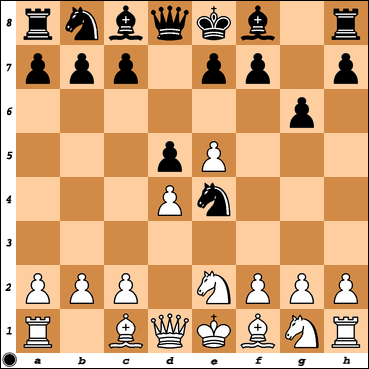 What is the trap hidden in this move, and what must black play to avoid it?
What is the trap hidden in this move, and what must black play to avoid it?
Black must play f6 to create a secure square on g5 for his e4 knight, as it is trapped.
I'm having alot of trouble with this stupid Blogspot. It wouldn't let Javascript work because it automatically inserts break tags every time I press return, even though I am in "Edit HTML" mode. So I learned how to turn off this "feature" and now the Javascript works. The only problem now is that all of my previous posts are completely screwed up because of the hidden break tags that are now gone. Anyway, back to the chess game.
My opponent didn't see this trap and so lost his knight next move after 5 ... Bg7? 6. f3! Ng5 7. Bxg5. Play then went on in a pretty standard fashion. I pushed to f4 to clear the f3 square for the king's knight and tried to develop my pieces to good squares. I missed the obvious 11. Bxd8 winning the queen, but still managed to win another piece. After 13. Bf6+ I had a huge bishop right in black's king position which is hard to dislodge. I pushed c3 to shore up my central pawn wedge and establish the light square bishop on the aggressive d3 square. And then there was 16... h6

What is white's move in this position?
The correct move is 17. Qh5! The queen cannot be taken because 17 ... gxh5 18. Bh7#.
Of course the real game didn't make it to move seventeen as my opponent resigned after 16 ... h6 because he had to go. But it was a pretty good place to resign anyway because it is a forced mate! The game below contains two ending variations that could have occurred, but keep in mind that they did not occur. I was thinking about 17. Qg4 which is not immediately winning, so I need to work on recognizing ccombinations more still.
Hello world. Tonight I participated in the Nightly 5 0 tournament on FICS. I usually do very very badly on these FICS tournaments, as it pairs you against highly rated players with very little time. But in this tournament I finished in 8th place with a 2.5/5 score! Go me. Here are the 5 games I played.
The first game featured me against a 1421 player. Opening was an English opening. He must have been half-asleep, because he missed several very simple tactics and I had a position where I could have ended with a Queen versus bishop. Unfortunately, by that time I had only about 20 seconds left on the clock and so couldn't make any moves. The game ended in a draw, which I was happy with, because I outplayed my opponent in the opening and middlegame.
waparker_Wedberg_2009_2_17_22_13.pgnSecond game featured a King's gambit, which I hate playing against. I had a losing position and then a winning position against a 1480 before losing on time. This was a position where I snatched material and had to endure a siege upon my back rank, but came out of it material up after my opponent blundered.
MauriceP_waparker_2009_2_18_01_39.pgnThird game was a Dutch defense stonewall variation. My opponent was closer to my own rating and missed several good moves. I managed to reach a position where I had complete control of the f and h files surrounding his king, and I won after my opponent failed to defend his king.
wojowhiskey_waparker_2009_2_18_01_45.pgnFourth game: French defense advance variation. I got into trouble early on, but after a very dubious bishop sacrifice (move 18) I freed my game up some. I then was able to win the piece back after some tactical fireworks centering around the theme of attacking the defender (moves 24 - 30). After all this it simplified into an endgame where I was a pawn up and with a knight versus a bishop. All the pawns were on the same side of the board so my knight was an asset. I managed to put all my pawns on dark squares so my opponent had nothing to attack with his bishop. I won on time after a very exciting endgame! Unfortunately I missed the two opportunities to just take the bishop and win but it is blitz.
waparker_trentthechessnut_2009_2_17_22_46.pgnFinal game: Stonewall attack (Bird's Opening). I just got thumped in this game by a 1678 rated player. Not too much to talk about in this game. I had a nasty pin going on my opponent that would have won a piece (19. Bd3 instead of what I played). Afterwards my position just started to crumble like feta cheese!
waparker_Lemurian_2009_2_18_01_52.pgnEnd results: waparker 2.5/5 (2 wins, 2 losses, 1 draw)
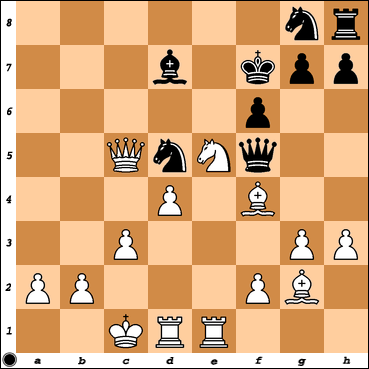 Position after 24. Ne5+
Position after 24. Ne5+
 Position after 24. Nh4, trapping the Queen.
Addendum: Just had a great little blitz game in the Philidor defense. This move order tends to lead to the so-called Lion system which seems popular and solid for black.
[Event "rated blitz match"]
[Site "Free Internet Chess Server"]
[Date "2009.01.30"]
[Round "?"]
[White "----"]
[Black "waparker"]
[Result "0-1"]
[WhiteElo "1067"]
[BlackElo "1147"]
[ECO "B07"]
[TimeControl "120+12"]
1. e4 d6
2. d4 Nf6
3. Nc3 Nbd7
4. Nf3 e5 {The Lion Variation. White enjoys more space and central control but black's setup is solid and hard to crack.}
5. dxe5 dxe5 {I have seen this exchange a few times today. It is just a bad idea for white. He loses his central control over e5 and also black's dark-square bishop, which is usually a problem for black the entire game, has just opened up to become a marvelous piece.}
6. Bb5? {I have seen this move once before today as well. It does nothing, only loses time.} c6
7. Bc4 Bb4 {White's e-pawn is hanging and black threatens to double white's pawns. Black could alternatively have played 7...b5 to gain some Queenside space and further punish White's incorrect bishop move.}
8. Bd2 Bxc3! 9. Bxc3 Nxe4 {White has won a pawn and still threatens to double white's pawns.}
10. Bb4? Qb6! {White must lose the bishop here as mate is threatened on f2. White should castle.}
11. c3?? Qxf2#
0-1
This game should go as an example why white should not exchange on e5.
Position after 24. Nh4, trapping the Queen.
Addendum: Just had a great little blitz game in the Philidor defense. This move order tends to lead to the so-called Lion system which seems popular and solid for black.
[Event "rated blitz match"]
[Site "Free Internet Chess Server"]
[Date "2009.01.30"]
[Round "?"]
[White "----"]
[Black "waparker"]
[Result "0-1"]
[WhiteElo "1067"]
[BlackElo "1147"]
[ECO "B07"]
[TimeControl "120+12"]
1. e4 d6
2. d4 Nf6
3. Nc3 Nbd7
4. Nf3 e5 {The Lion Variation. White enjoys more space and central control but black's setup is solid and hard to crack.}
5. dxe5 dxe5 {I have seen this exchange a few times today. It is just a bad idea for white. He loses his central control over e5 and also black's dark-square bishop, which is usually a problem for black the entire game, has just opened up to become a marvelous piece.}
6. Bb5? {I have seen this move once before today as well. It does nothing, only loses time.} c6
7. Bc4 Bb4 {White's e-pawn is hanging and black threatens to double white's pawns. Black could alternatively have played 7...b5 to gain some Queenside space and further punish White's incorrect bishop move.}
8. Bd2 Bxc3! 9. Bxc3 Nxe4 {White has won a pawn and still threatens to double white's pawns.}
10. Bb4? Qb6! {White must lose the bishop here as mate is threatened on f2. White should castle.}
11. c3?? Qxf2#
0-1
This game should go as an example why white should not exchange on e5.
 Compare white's central control and black's bad dark-square bishop above with below, after the exchange of pawns:
Compare white's central control and black's bad dark-square bishop above with below, after the exchange of pawns:

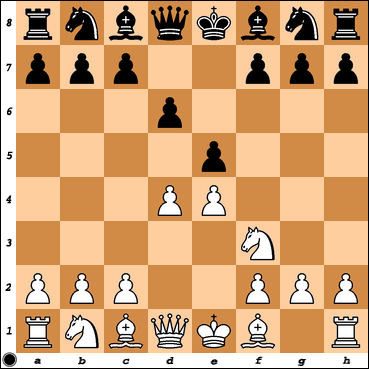 The Philidor defense with 3. d4. White aims to take control of the center. If it were white to move, white would exchange pawns, then Queens, then white would win the e-pawn and black would lose the right to castle. Usually black here will develop the queen's knight to d7 to protect the e-pawn (3 ... Nc6 is regarded as a bad move, as it can transpose into a variation of the Ruy Lopez favorable for white, the Steinitz Defense, and doesn't resolve the threat of removing the Queens from the board). The other options are to exchange the center pawns, or to gambit the pawn with f5.
3 ... exd4 Black choses the exchange variation. In fact I've never seen anyone play anything else on the internet in the Philidor's defense.
4. Nxd4 Bd7 Perhaps this move is too passive. A better line seems to be 4 ... Nf6 attacking the e pawn, 5. Nc3 g6 preparing the kingside fianchetto.
5. Bc4 Nc6 6. O-O Nf6 7. Nc3
The Philidor defense with 3. d4. White aims to take control of the center. If it were white to move, white would exchange pawns, then Queens, then white would win the e-pawn and black would lose the right to castle. Usually black here will develop the queen's knight to d7 to protect the e-pawn (3 ... Nc6 is regarded as a bad move, as it can transpose into a variation of the Ruy Lopez favorable for white, the Steinitz Defense, and doesn't resolve the threat of removing the Queens from the board). The other options are to exchange the center pawns, or to gambit the pawn with f5.
3 ... exd4 Black choses the exchange variation. In fact I've never seen anyone play anything else on the internet in the Philidor's defense.
4. Nxd4 Bd7 Perhaps this move is too passive. A better line seems to be 4 ... Nf6 attacking the e pawn, 5. Nc3 g6 preparing the kingside fianchetto.
5. Bc4 Nc6 6. O-O Nf6 7. Nc3
 Black has finally started to challenge my presence in the center with ... Nf6. I have some slight pressure on the f7 pawn.
8 ... Ne5 8. Bb3 Be6?
After a quick inspection of this position I realized I would win a center pawn by exchanging. However, for whatever reason I took with the bishop first, giving me two knights in an open game. Better is 9. Nxe6 fxe6 10. Bxe6
9. Bxe6 fxe6 10. Nxe6 Qe7 11. Nf4
Black has finally started to challenge my presence in the center with ... Nf6. I have some slight pressure on the f7 pawn.
8 ... Ne5 8. Bb3 Be6?
After a quick inspection of this position I realized I would win a center pawn by exchanging. However, for whatever reason I took with the bishop first, giving me two knights in an open game. Better is 9. Nxe6 fxe6 10. Bxe6
9. Bxe6 fxe6 10. Nxe6 Qe7 11. Nf4
 I chose Nf4 because I want to establish a knight on d5 on the open file. It will tempt black to play c6 to kick the knight which permanently weakens the d6 pawn. This is from Nimzowitsch's theory of play on open files.
11 ... O-O-O 12. Nfd5 Nxd5 13. Nxd5 Qd7
14. Bg5 Re8 15. f4 h6 16. Bh4 Nc6 17. Qd3 g5
I chose Nf4 because I want to establish a knight on d5 on the open file. It will tempt black to play c6 to kick the knight which permanently weakens the d6 pawn. This is from Nimzowitsch's theory of play on open files.
11 ... O-O-O 12. Nfd5 Nxd5 13. Nxd5 Qd7
14. Bg5 Re8 15. f4 h6 16. Bh4 Nc6 17. Qd3 g5
 This is where I felt I went slightly off. My bishop has become a target to allow white to open the files directed toward my king. Rybka still gives white a two pawn advantage, so I guess it's not that dangerous. I missed Rybka's choice 18. Nf6 in this position, forking the queen and rook. 17. Qd3 seems quiet but I wanted to connect the rooks and the Queen becomes very useful on the f1-a6 diagonal later.
18. fxg5 hxg5 19. Bxg5
Not only have I won another pawn, but the f-file is now open for me to double rooks.
19 ... Re5?
This looks like a blunder. It allows me to exchange my problem piece, this hanging bishop, for one of the rooks by playing...
20. Bf6 Bg7 21. Bxe5 Bxe5
This is where I felt I went slightly off. My bishop has become a target to allow white to open the files directed toward my king. Rybka still gives white a two pawn advantage, so I guess it's not that dangerous. I missed Rybka's choice 18. Nf6 in this position, forking the queen and rook. 17. Qd3 seems quiet but I wanted to connect the rooks and the Queen becomes very useful on the f1-a6 diagonal later.
18. fxg5 hxg5 19. Bxg5
Not only have I won another pawn, but the f-file is now open for me to double rooks.
19 ... Re5?
This looks like a blunder. It allows me to exchange my problem piece, this hanging bishop, for one of the rooks by playing...
20. Bf6 Bg7 21. Bxe5 Bxe5
 Black's compensation is a very strong bishop on e5 looking straight at my king. Here's where I start making defensive mistakes, which, if black had played "energetically" would have made for a much tougher position for me. Here Rybka suggests 22. h3
22. g3? Qh7 23. Rf2?
Here Rybka suggests 23 ... Bxg3 24. Qxg3 Rg8 pinning the Queen to the king.
23 ... Bd4
Trying to pin my rook to my King, but I found Ne3 blocking.
24. Ne3 Be5
Black's compensation is a very strong bishop on e5 looking straight at my king. Here's where I start making defensive mistakes, which, if black had played "energetically" would have made for a much tougher position for me. Here Rybka suggests 22. h3
22. g3? Qh7 23. Rf2?
Here Rybka suggests 23 ... Bxg3 24. Qxg3 Rg8 pinning the Queen to the king.
23 ... Bd4
Trying to pin my rook to my King, but I found Ne3 blocking.
24. Ne3 Be5
 Now the threat of Bxg3 isn't as dangerous after I double rooks on the f-file because I can force the exchange of rooks.
25. Raf1 b6?
This seems to be a losing move, as it opens up the diagonal for Qa6+.
26. Qa6+ Kd8??
Better was Kb8, as Rf8+ can be blocked by Nd8. This is the losing move. After this move Rybka's analysis jumps up to +300 (i.e. forced win for white).
27. Rf8+ Rxf8 28. Rxf8+ Ke7
Now the threat of Bxg3 isn't as dangerous after I double rooks on the f-file because I can force the exchange of rooks.
25. Raf1 b6?
This seems to be a losing move, as it opens up the diagonal for Qa6+.
26. Qa6+ Kd8??
Better was Kb8, as Rf8+ can be blocked by Nd8. This is the losing move. After this move Rybka's analysis jumps up to +300 (i.e. forced win for white).
27. Rf8+ Rxf8 28. Rxf8+ Ke7
 What is the winning move in this position?
29. Qc8!! 1-0
I am glad I found this move. Here is the position:
What is the winning move in this position?
29. Qc8!! 1-0
I am glad I found this move. Here is the position:
 White threatens mate in two places: if this were white to move, he could play Nd5# or Qe8#. It is impossible for black to guard these two squares at once. So, for example, if Qg6 then Nd5#, if Nb4 then Qe8#. If Nd8 then Qxd8+ Ke6 Qe8#. For black, Qf7 covers both squares, but is met by Nd5+ Qxd5 Qe8#. This is the point in the game where black resigned. In fact there is only one move that black can play: d5, to create an escape square.
Rybka continuation:
[29 ... d5 30. Re8+ Kf6 31. Qe6+ Kg7 32. Nf5+
White threatens mate in two places: if this were white to move, he could play Nd5# or Qe8#. It is impossible for black to guard these two squares at once. So, for example, if Qg6 then Nd5#, if Nb4 then Qe8#. If Nd8 then Qxd8+ Ke6 Qe8#. For black, Qf7 covers both squares, but is met by Nd5+ Qxd5 Qe8#. This is the point in the game where black resigned. In fact there is only one move that black can play: d5, to create an escape square.
Rybka continuation:
[29 ... d5 30. Re8+ Kf6 31. Qe6+ Kg7 32. Nf5+
 Black must give up his queen for the knight.
32 ...Qxf5 33. exf5 Bd4+ 34. Kg2 Ne5
Black must protect from the mate on g6, but now black does not protect f6.
35. Re7+ Kf8 (35. ... Kh8 36. Qc8# ) 36. Qf6+ Kg8 37. Qg7# 1-0 ]
So in summary, black played a bit passively in the opening, and I won a few pawns and then the exchange of bishop for rook. Then I blundered, allowing black to get some pressure on the h-file, but black missed the move Bxg3. After doubling on the f-file and a final pair of blunders from black, I reached a devastating mating position (mating net).
Thanks to chessvideos.tv for their diagram generator, and to Chessops for the info on the Philidor's defense.
Finally I completed a game on this blog.
Black must give up his queen for the knight.
32 ...Qxf5 33. exf5 Bd4+ 34. Kg2 Ne5
Black must protect from the mate on g6, but now black does not protect f6.
35. Re7+ Kf8 (35. ... Kh8 36. Qc8# ) 36. Qf6+ Kg8 37. Qg7# 1-0 ]
So in summary, black played a bit passively in the opening, and I won a few pawns and then the exchange of bishop for rook. Then I blundered, allowing black to get some pressure on the h-file, but black missed the move Bxg3. After doubling on the f-file and a final pair of blunders from black, I reached a devastating mating position (mating net).
Thanks to chessvideos.tv for their diagram generator, and to Chessops for the info on the Philidor's defense.
Finally I completed a game on this blog.
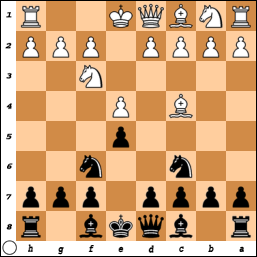 The Two Knights Defense.
4. Ng5 d5 (black must sacrifice a pawn to stop the double attack on f7
5. exd5 b5! (The Ulvestad Variation). This caught my opponent off guard which is probably worth as much in generating an advantage as the variation itself.
The Two Knights Defense.
4. Ng5 d5 (black must sacrifice a pawn to stop the double attack on f7
5. exd5 b5! (The Ulvestad Variation). This caught my opponent off guard which is probably worth as much in generating an advantage as the variation itself.
 The Ulvestad Variation. According to the video, the correct move for white is Bf1 for tactical reasons (i.e. the unprotected g2 pawn. But, white sees a free pawn and so he feels compelled to take it.
6. Bxb5 Qxd5 7. Bxc6 Qxc6
Black trades immediately to save the g2 pawn as he doesn't want to lose time with 7. Bf1.
8. O-O Bb7
The Ulvestad Variation. According to the video, the correct move for white is Bf1 for tactical reasons (i.e. the unprotected g2 pawn. But, white sees a free pawn and so he feels compelled to take it.
6. Bxb5 Qxd5 7. Bxc6 Qxc6
Black trades immediately to save the g2 pawn as he doesn't want to lose time with 7. Bf1.
8. O-O Bb7
 Threatening checkmate.
9. f3
Protects against the mate but allows me to develop with check.
9 ... Bc5+ 10. Kh1 h6
Notice how white has only one developed piece whereas black has three and can castle queenside to develop the rook to the central file. Now 9. f3 is shown to be a bad idea as the knight must move to h3 instead of the more natural Nf3. Now I can accelerate my kingside pawn attack by harassing this knight, taking advantage of the pin on the f3 pawn, and the fact that white needs two moves to start developing his queen or bishop.
11. Nh3 g5 12. d3 g4
Threatening checkmate.
9. f3
Protects against the mate but allows me to develop with check.
9 ... Bc5+ 10. Kh1 h6
Notice how white has only one developed piece whereas black has three and can castle queenside to develop the rook to the central file. Now 9. f3 is shown to be a bad idea as the knight must move to h3 instead of the more natural Nf3. Now I can accelerate my kingside pawn attack by harassing this knight, taking advantage of the pin on the f3 pawn, and the fact that white needs two moves to start developing his queen or bishop.
11. Nh3 g5 12. d3 g4
 Gaining time on the knight.
I will continue this later!
Gaining time on the knight.
I will continue this later!